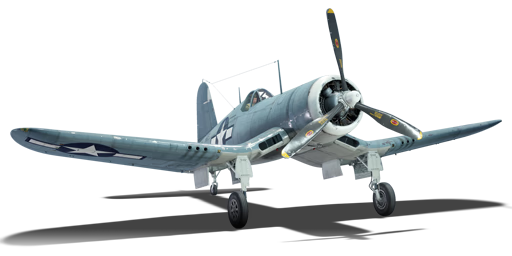



The F4U-1A is an American naval fighter. It has been in the game since the start of the Open Beta Test prior to Update 1.27.
This is the first plane available in the F4U Corsair family of the naval aircraft line and it will give a pilot a good idea of the flight characteristics pertinent to this family of aircraft. Sporting a very distinctive silhouette due to its inverted gull wings, it's never hard to pick a Corsair out of a crowd. However, the inverted gull wings are a "double-edged sword", as it enables the Corsair to turn well at high speeds and have a good roll rate, but makes it turn mediocrely at low speeds. While not as powerful as its later siblings, the Pratt & Whitney R-2800-8W 18-cylinder radial can still propel the Corsair to a respectable 646 km/h at around 6,800 m. The Corsair also has a weak airframe that is very susceptible to incendiary rounds, so make sure to use the plane's roll rate and good high-speed performance in order to survive.
flaps
flaps
flaps
brake
| Belt | Belt filling | Armor penetration (mm) at a distance: | |||||
|---|---|---|---|---|---|---|---|
| 10 m | 100 m | 500 m | 1000 m | 1500 m | 2000 m | ||
| T/Ball/Ball/I/AP-I | 28 | 26 | 18 | 11 | 7 | 4 | |
| AP-I/AP-I/AP-I/T/I | 28 | 26 | 18 | 11 | 7 | 4 | |
| T/AP/AP/AP/AP-I/I | 30 | 27 | 20 | 13 | 9 | 6 | |
| T/T/T/T/T/AP-I | 28 | 26 | 18 | 11 | 7 | 4 | |
| AP/AP-I/AP-I/I/I | 30 | 27 | 20 | 13 | 9 | 6 | |












Flight performance | |
|---|---|
Survivability |
|---|
Weaponry | |
|---|---|